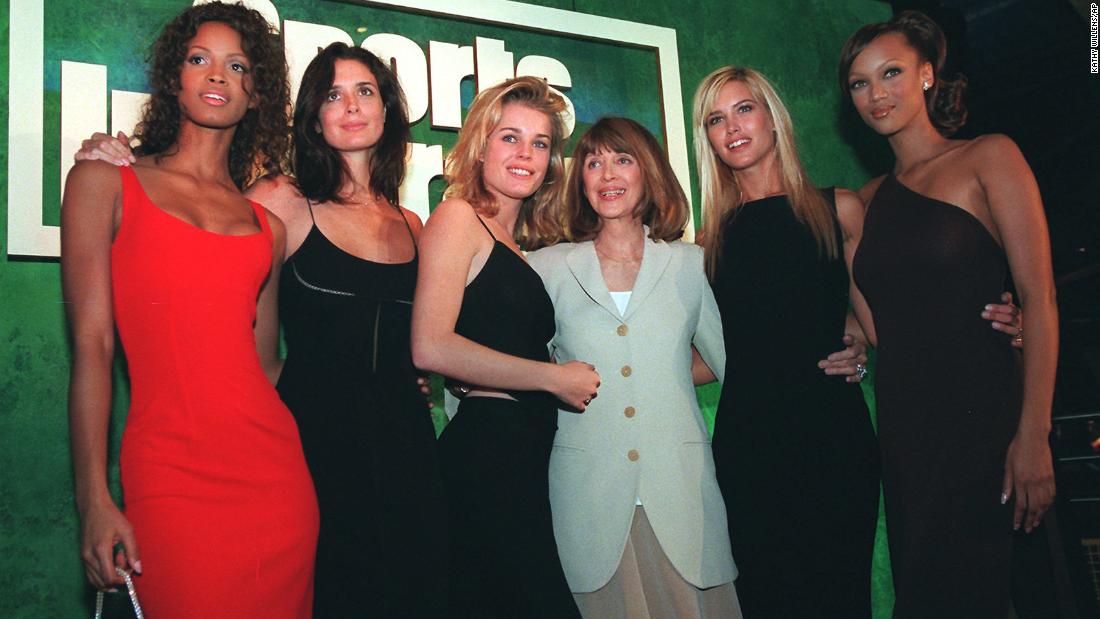The pioneering editor widely credited with growing the iconic — and often infamous — Sports Illustrated Swimsuit Issue into a cultural institution has died at 96.
Campbell joined Sports Illustrated as an assistant and reporter in the magazine’s fashion department in the early 1960s, after a stint at Glamour.
Her career took off after the launch of SI’s Swimsuit Issue, which was first suggested by managing editor Andre Laguerre to fill the magazine’s typically slow winter months.
Its first iteration — a six-page cover feature with model Babette March wearing a white two-piece swimsuit — appeared in January 1964. Campbell’s work on the Swimsuit Issue began the following year, soon establishing her as a powerful figure in the industry.

Campbell (right, with binoculars) on set during a Swimsuit Issue shoot. Credit: Joan Truscio
Eschewing much of the “skinny chic” aesthetic lauded by the fashion industry at the time, Campbell’s vision was clear. On her casting process, she told journalist Michael MacCambridge in an interview for his book “The Franchise: A History of Sports Illustrated Magazine” that, “I went to California because I thought we should use more natural kinds of women.”
“I wanted them to look like real people that were beautiful, and I think our audience related to that,” Sports Illustrated quoted Campbell as saying in their obituary.
The first model she chose was a fresh-faced teen named Sue Peterson, who featured on Campbell’s first cover in a black one piece with side cutouts and a red belt. It set the precedent for decades of issues’ worth of scantily-clad white models — and, while far from what would be considered overtly revealing swimwear today, decades worth of reader outrage.
Beyond canceled subscriptions, the Swimsuit Issue also sparked protests from groups, including the National Organization of Women, who accused the magazine of objectifying women.

Models in the 2008 Sports Illustrated Swimsuit Issue wear swimsuits designed by Pompei Beach, in New York, on April 24, 2008. Credit: Andrew Harrer/Bloomberg/Getty Images
Campbell retired in 1996. Her last issue featured Tyra Banks, the first Black model to appear on the magazine’s cover (though Banks shared the cover with Argentinian model Valerie Mazza). Other famous models who fronted the Swimsuit Issue under Campbell’s tenure included Elle Macpherson, Christie Brinkley, Kathy Ireland, Paulina Porizkova and Carol Alt, among others.
Since 1997, the Swimsuit Issue has been printed as a standalone edition, separate from the regular magazine. It has expanded into televised specials and documentaries; a reality TV series and an open casting call.
In recent years, a greater commitment to diversity in the issue’s pages has seen the inclusion of plus-size, transgender and disabled models. Many an athlete — including tennis players Venus and Serena Williams, Caroline Wozniacki and Naomi Osaka, skier Lindsey Von, wrestler Ronda Rousey and racecar driver Danica Patrick — has featured in the magazine and on its cover; celebrities like Beyoncé, Kim Kardashian and Megan Thee Stallion have also landed cover spots.
Note:- (Not all news on the site expresses the point of view of the site, but we transmit this news automatically and translate it through programmatic technology on the site and not from a human editor. The content is auto-generated from a syndicated feed.))



